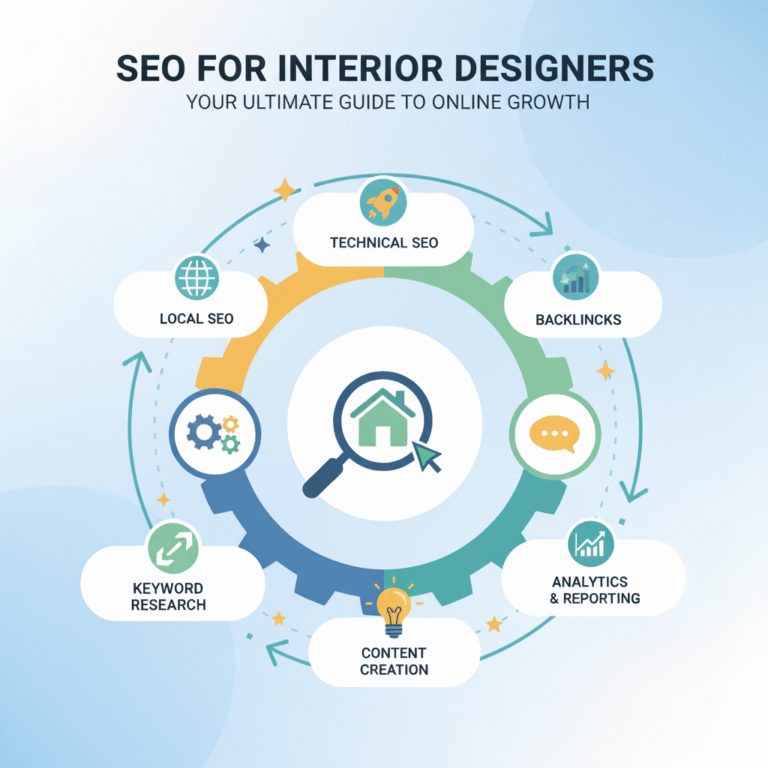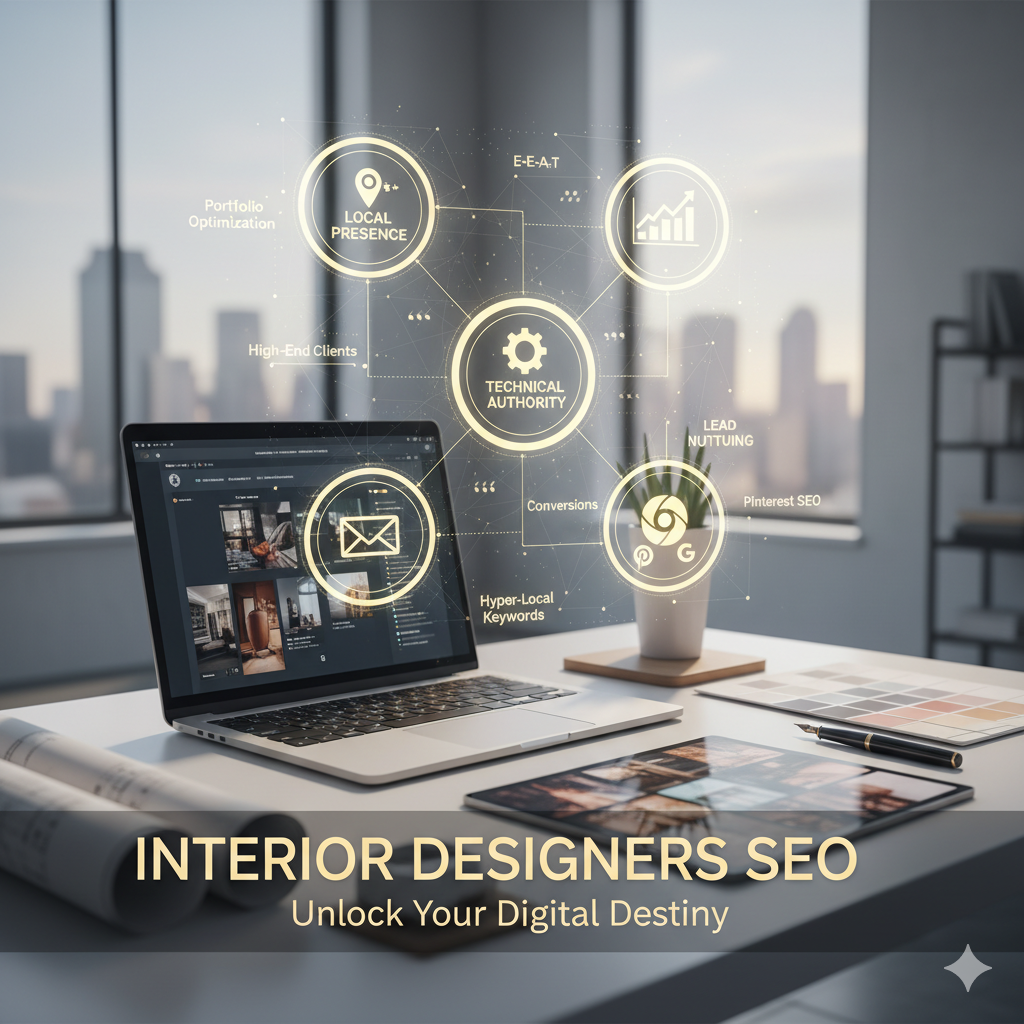If you’re an interior designer, you already know how important first impressions are. A beautifully designed space speaks for itself. But here’s the thing: your future clients aren’t just walking past your studio anymore they’re searching online. And if your website doesn’t show up on Google or in AI tools like ChatGPT, Gemini, or Perplexity, you’re practically invisible.
That’s where SEO (Search Engine Optimization) comes in. Don’t worry, you don’t need to be super technical to make it work. This guide breaks SEO down into simple steps tailored for interior designers who want to bring in more clients.
Step 1: Understand What Your Clients Are Searching For
SEO starts with keywords the words and phrases people type into Google (and now also ask AI tools). For interior designers, clients often search things like:
- “interior designer near me”
- “modern living room design ideas”
- “luxury apartment interior design [city]”
- “affordable interior design services”
Make a list of keywords around:
- Services you provide (e.g., “residential interior design,” “office interior design”).
- Locations you serve (e.g., “interior designer in Mumbai,” “New York apartment design”).
- Design styles you’re known for (e.g., “minimalist interior design,” “Scandinavian living room”).
These keywords help both Google rankings and AI citations, since AI models often pull content directly from well-optimized pages.
Step 2: Optimize Your Website Pages
Once you have keywords, weave them naturally into your website’s:
- Homepage — Clearly state who you are, where you’re located, and what you offer.
- Service Pages — Each service (residential, office, commercial) deserves its own page.
- Portfolio Pages — Optimize project descriptions with keywords like “modern home design in [city].”
- Contact Page — Add your business address and phone number for local SEO.
Write in a way that’s clear and helpful. That makes your content more likely to be cited in AI-generated answers as well.
Step 3: Start Blogging for SEO and AI
Blogging isn’t just for lifestyle influencers it’s a powerful tool for both SEO and AI visibility. Write blog posts like:
- “10 Modern Kitchen Design Trends in 2025”
- “How to Choose the Right Interior Designer”
- “Small Apartment Interior Design Ideas That Save Space”
Each post targets a keyword your potential clients are Googling. But also keep in mind: AI tools love to cite informative, structured, and clear answers. A well-written blog post can end up being quoted in AI responses, bringing you visibility beyond Google.
Step 4: Focus on Local SEO
Most interior designers serve clients in specific cities. That’s why local SEO is crucial.
- Set up and optimize your Google Business Profile (add photos, services, client reviews).
- Use your city name in your website titles and content (e.g., “Interior Designer in Bangalore”).
- Get listed in local directories and design platforms like Houzz.
Local SEO helps you show up when someone types “interior designer near me” into Google, but it also makes AI tools more likely to reference you when users ask about designers in your area.
Step 5: Showcase Case Studies & Reviews
Nothing convinces clients like proof. Dedicate a page or blog posts to:
- Case Studies — Walk through your projects (before/after photos, process, results).
- Testimonials — Ask happy clients to share their experience.
Specific details (budgets, timelines, unique challenges) make your content richer. AI tools also prefer citing detailed and unique examples over generic text.
Step 6: Build Backlinks (and Citability)
Backlinks are links from other websites to yours. Google sees them as a vote of confidence. AI tools also prioritize content that’s well-linked and authoritative. For interior designers:
- Get featured in online magazines or blogs (“Top Interior Designers in Canada”).
- Collaborate with architects or real estate firms and ask for a link.
- Share your design work on platforms like Medium, Pinterest, and Houzz with links back to your site.
Step 7: Track, Improve, and Stay AI-Friendly
SEO isn’t a one-time task. Use free tools like Google Analytics and Google Search Console to check:
- Which keywords bring traffic.
- Which pages clients visit the most.
- Where visitors drop off.
And here’s the new part: Check how AI tools mention your website. Regularly test prompts like “best interior designers in [city]” on ChatGPT or Perplexity to see if your site is referenced. If not, adjust your content to be clearer, more detailed, and structured.
Conclusion
SEO for interior designers is no longer just about ranking on Google. Today, it’s also about being cited by AI tools, which more and more people are using to find services and inspiration.
Think of it this way: you’re not just decorating a website for search engines; you’re creating a digital portfolio that can be referenced by Google and by AI. With consistent effort, you’ll attract more website visitors, leads, and clients both locally and internationally.
Ready to Get More Interior Design Clients Online?
If you’re serious about growing your interior design business with SEO, I can help. I specialize in writing AI-optimized SEO content for architects, interior designers, and creative professionals content that not only ranks on Google but also gets cited in AI tools.
Let’s turn your website into a steady lead generator.
FAQs
Keywords are the words and phrases that potential clients type into search engines like Google or ask AI tools when looking for interior design services. For example: “modern interior designer in Mumbai”, “residential kitchen design ideas”, or “affordable interior designers near me”. Using the right keywords on your website, blog posts, and portfolio pages helps your business show up in search results and attracts clients who are actively looking for your services.
Promoting yourself as an interior designer requires a mix of online presence, networking, and showcasing your work:
Website & Portfolio: Create a professional website with your projects, services, and testimonials. Optimize it for search engines using relevant keywords.
Social Media: Use Instagram, Pinterest, and LinkedIn to share your projects, design tips, and client stories.
Content Marketing: Write blogs or articles that answer questions your clients have, such as “How to design a small living room” or “Top modern kitchen trends.”
Networking: Collaborate with architects, real estate agents, or other designers to reach new clients.
Local SEO: Make sure your business appears in local searches, Google Maps, and directories like Houzz or Yelp.
To get more clients, focus on both visibility and credibility:
SEO & Blogging: Optimize your website with keywords and create blog content that attracts potential clients.
Social Proof: Display testimonials, reviews, and case studies on your site.
Lead Magnets: Offer free resources like “Interior Design Checklist” or free consultation calls to capture leads.
Referrals: Encourage past clients to refer you and consider building partnerships with real estate agents or contractors.
Paid Ads (Optional): Facebook, Instagram, or Google Ads targeted to your city or niche can bring in leads faster.
Effective advertising depends on your target audience:
Online Platforms: Instagram, Pinterest, LinkedIn, and Facebook are ideal for visually showcasing your work.
Google Ads: Target local searches like “interior designer near me” to capture ready-to-hire clients.
Design Portals: List your services on platforms like Houzz, ArchDaily, or Homify to reach people actively searching for designers.
Local Publications: Magazines, newspapers, or city-specific lifestyle blogs can help attract clients in your area.
Increasing sales is about combining marketing with client experience:
Showcase Expertise: Use blogs, case studies, and portfolio pages to demonstrate your skill and unique style.
Offer Packages: Create clear service packages (e.g., full-home design, consultation-only, commercial spaces) to make it easy for clients to hire you.
Follow-Up: Keep in touch with past clients and leads via email or social media; repeat clients are easier to convert.
Upsell & Cross-Sell: Offer additional services like 3D renderings, color consultations, or furniture selection.
Optimize Online Visibility: More traffic to your site through SEO, AI citations, and local SEO means more potential clients discovering your services.

